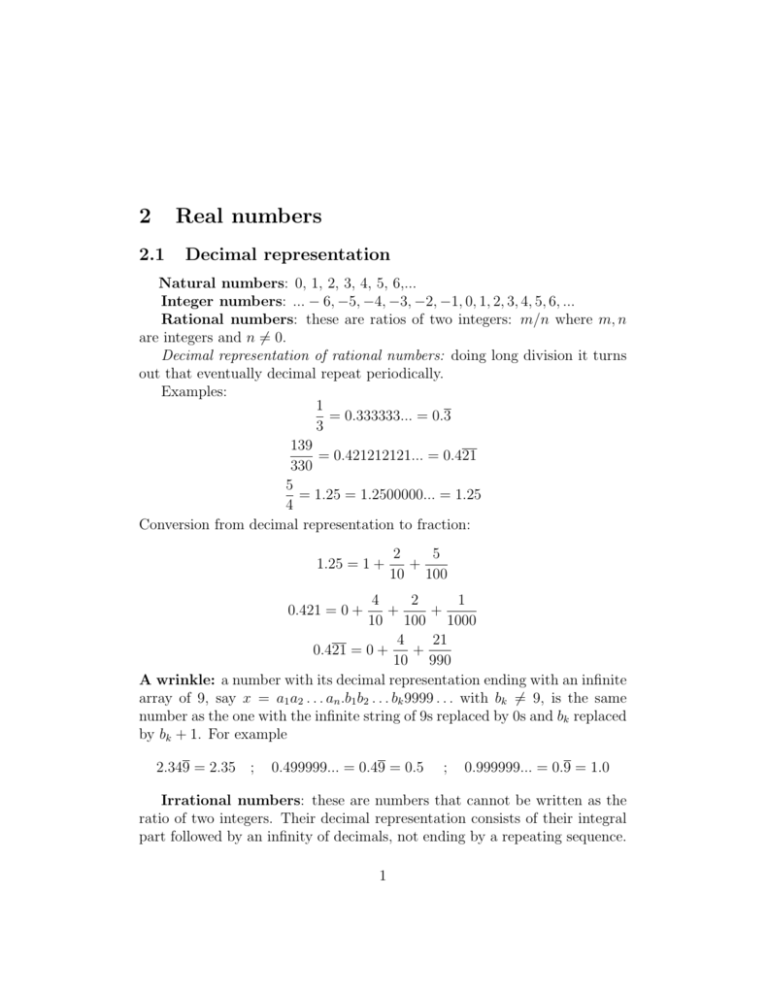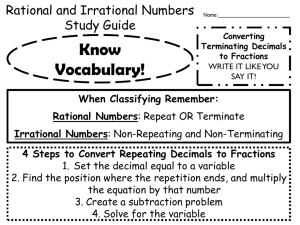2 Real numbers
advertisement

2
Real numbers
2.1
Decimal representation
Natural numbers: 0, 1, 2, 3, 4, 5, 6,...
Integer numbers: ... − 6, −5, −4, −3, −2, −1, 0, 1, 2, 3, 4, 5, 6, ...
Rational numbers: these are ratios of two integers: m/n where m, n
are integers and n 6= 0.
Decimal representation of rational numbers: doing long division it turns
out that eventually decimal repeat periodically.
Examples:
1
= 0.333333... = 0.3
3
139
= 0.421212121... = 0.421
330
5
= 1.25 = 1.2500000... = 1.25
4
Conversion from decimal representation to fraction:
1.25 = 1 +
2
5
+
10 100
4
2
1
+
+
10 100 1000
21
4
+
0.421 = 0 +
10 990
A wrinkle: a number with its decimal representation ending with an infinite
array of 9, say x = a1 a2 . . . an .b1 b2 . . . bk 9999 . . . with bk 6= 9, is the same
number as the one with the infinite string of 9s replaced by 0s and bk replaced
by bk + 1. For example
0.421 = 0 +
2.349 = 2.35 ;
0.499999... = 0.49 = 0.5
;
0.999999... = 0.9 = 1.0
Irrational numbers: these are numbers that cannot be written as the
ratio of two integers. Their decimal representation consists of their integral
part followed by an infinity of decimals, not ending by a repeating sequence.
1
For example
3.141592653589793238...
These are the first digits of a special number we call π. The number π is
defined through its properties (π is the ratio between the circumference of
any circle and its diameter),
and not through its decimals.
√
Another example: 2 = 1.4142135623730... is that number whose square
is 2; this number turns out to be irrational.
We can define real numbers by their decimal representation. A real number is an infinite sequence of digits as follows: an integer number followed,
after the decimal point, by an infinite sequence of digits:
a1 a2 a3 . . . an . b1 b2 b3 . . .
where a1 , a2 , . . . , an , b1 b2 b3 . . . ∈ {0, 1, 2, . . . 9}
with the agreement that
a1 a2 . . . an .b1 b2 . . . bk 9999 . . . = a1 a2 . . . an , b1 b2 . . . (bk + 1)0000 . . .
So can we really work with irrational numbers, if we can only know a
finite number of their decimals?
When we do calculations for practical applications, we do use decimals,
but we stop after a finite number of them: in fact we take an approximation
by a rational number. Do we then need all those infinitely many decimals?
And how do we work with irrational numbers? Answer: through the properties that those numbers have.
Let us take a look at the properties of real numbers.
2
2.2
Properties of real numbers
The set of all real numbers has the following properties I-V:
I. Order properties
I.1 For any two real numbers a, b one, and only one of the following hold
a<b
or b < a
or a = b
I.2 Transitivity:
If a < c and c < b
then a < b
I.3 Between any two numbers there is another number:
If a < b then there is c so that a < c < b
II. Addition
There is an operation between any two real numbers a, b, called addition,
denoted a + b so that:
II.1 (a + b) + c = a + (b + c) (associativity)
II.2 a + 0 = 0 + a = a (0 is a neutral element)
II.3 Any number a has an opposite, denoted −a, so that a + (−a) = 0.
II.4 a + b = b + a (commutativity)
II.5 If a < b than a + c < b + c.
III. Multiplication
There is an operation between any two real numbers a, b, called multiplication, denoted ab (or a · b) so that:
III.1 (ab)c = a(bc) (associativity)
III.2 a · 1 = 1 · a = a (1 is a neutral element)
III.3 Any number a 6= 0 has an inverse, denoted a1 , so that a · a1 = 1.
III.4 ab = ba (commutativity)
III.5 a(b + c) = ab + ac (distributivity)
III.6 If a < b and c > 0 then ac < bc.
IV. Archimedean property
Given any number a there is a larger natural number n: a < n.
V. Existence of the least upper bound
Any nonempty set of real numbers which is bounded above has a supremum.
3
Property V will be discussed in what follows.
Note that the set of rational numbers have all the properties I-IV.
Exercises
2.1 Convert to a fraction the following numbers
a = 3.45123
b = 0.1
c = 0.9
Explain the result you got in c.
2.2 Which of the properties I-IV are not satisfied by the set of integer
numbers?
2.3 The properties listed at §2.2 are enough to deduce all the other properties of real numbers that you know. Here is an example.
Use only the properties listed in §2.2 to show that if a < b then −a > −b. 1
1
Hint: use II.2, II.3, II.5.
4






